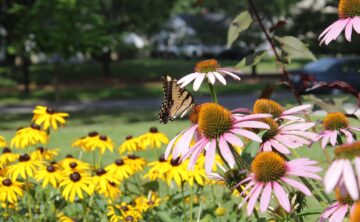Your Yard, the Ultimate Ecosystem
How a Balanced Landscape Supports Life
June 11, 2025
Summer in the Twin Cities is a season of vibrant growth. Trees stretch their canopies wide, lawns thicken into lush green carpets, and the hum of life—birds, bees, and insects—fills the air. What may seem like a simple backyard is actually a dynamic, living ecosystem. When cared for thoughtfully, your yard can become a thriving sanctuary that supports both people and nature.
A balanced landscape doesn’t happen by accident. It’s the result of intentional care where trees, turf, and even pest management work together to create a healthy, resilient environment.
“The atmosphere, the earth, the water and the water cycle—those things are good gifts. The ecosystems, the ecosphere, those are good gifts. We have to regard them as gifts because we couldn’t make them. We have to regard them as good gifts because we couldn’t live without them.”
—Wendell Berry, American author, poet, environmentalist, and advocate for sustainable agriculture
The Interconnected Life of Your Landscape
Trees: The Foundation of a Thriving Yard
At the heart of your yard’s ecosystem are the trees. In the Twin Cities, native species like maples, oaks, and elms provide more than just shade. They regulate temperature, clean the air, and offer critical habitat for birds and beneficial insects. Just as their branches support life above, their roots quietly enrich the soil below, nurturing the plants, grasses, and organisms that make your landscape thrive.


Lawns: More Than Just Green Space
Whether it’s a place for kids to play or pollinators to forage, your lawn is more than just grass, it’s a living part of your landscape. When mowed high and watered deeply, it becomes a sponge for rainwater, filtering runoff before it reaches our lakes and rivers. A healthy lawn also crowds out weeds naturally and provides a soft, safe space for families and pets to enjoy the outdoors. But it’s not just about grass—incorporating native groundcovers or letting clover bloom can support pollinators and reduce the need for chemical inputs.
Pest Control: Protecting Balance, Not Breaking It
Even the most vibrant yard can be thrown off balance by pests. In Minnesota, ants, wasps, mosquitoes, ticks, mice, boxelder bugs, and Asian lady beetles are common intruders. While some are simply a nuisance, others can damage plants, spread disease, or invade your home. Managing these pests is essential, not to eliminate all insects entirely, but to restore balance and protect the beneficial species that keep your yard thriving.


A Yard That Gives Back
When tree care, lawn maintenance, and pest control are approached as parts of a whole, your property becomes more than just a pretty space—it becomes a functioning ecosystem. Trees that are pruned and protected from invasive pests continue to provide shade and shelter. Lawns that are nurtured with smart mowing and watering practices become resilient and self-sustaining. And pests that are managed thoughtfully allow beneficial species to flourish.
This summer, take a moment to walk through your yard and observe the life it supports. From the birds nesting in your trees to the bees buzzing through your flowers, every element plays a role. With a little care and intention, your landscape can become a haven not just for you, but for the entire web of life that calls it home.
Other items you may be interested in:

Shade for a Brighter Future
Audrey Hepburn said, “To plant a garden is to believe in tomorrow”. You invest in watering, pruning, and fertilizing, trusting that one day you will experience the fruit of your labor.

Caring for Your World
Rainbow understands that your property is more than just a collection of trees, lawns, and structures. It’s a living ecosystem uniquely connected to your life.

2025 Spruce Health Alert
Seasonal stressors are putting these trees at risk and causing severe cases of spider mites, needle drop, and a thinning, browning canopy.
